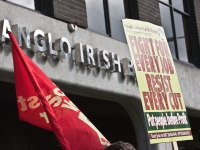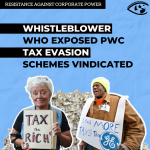EuroZone Profiteers: Ireland
From Miraculous Beast to Failed Civilization

Where: Ireland. The Celtic Tiger "appeared like a miraculous beast materializing in a forest clearing," wrote Oxford historian Roy Foster in his recent book: Luck and the Irish: A Brief History of Change 1970-2000. "Economists are still not entirely sure why."[212] The scheme drew a tight concentration of major European banks. If you stand in front of the Jeanie Johnston, a replica of a boat that took 19th century Irish emigrants to the Americas, you can look straight down Commons Street at the headquarters of Depfa. Just beyond it, on Harbourmaster Place, sits Deutsche Bank. To your left are Dexia inside Touche House and the headquarters of the IFSC. To your right is the new Dublin Convention Center, financed by Depfa, and then an unfinished building intended as headquarters of Anglo Irish Bank. Swivel around, and across the bridge on George's Quay are the old offices of Sachsen Landesbank (Sachsen LB) from Leipzig in Saxony. The crash began in late summer 2007. Rumors had already started to circulate about a looming crisis on subprime mortgages, and many banks had stopped making short-term loans, choosing instead to hoard their cash. With no easy money to borrow to finance its long-term loans, the landesbanken-notably Sachsen LB-that were speculating on interest rate differences hit a wall. [212] Roy Foster, "Luck and the Irish: A Brief History of Change 1970-2000," Allen Lane, October 2007 [213] Brian Laverty and Timothy O'Brien, "For Insurance Regulators, Trails Lead to Dublin," New York Times, April 1, 2005. http://www.nytimes.com/2005/04/01/business/worldbusiness/01irish.html [214] International Financial Services Centre, "About the IFSC," IFSC, Date Accessed: September 1, 2013. http://www.ifsc.ie/page.aspx?idpage=6 [215] Kestrel Funding P.L.C. Base Prospectus Supplement, Irish Stock Exchange, June 26, 2007. http://www.ise.ie/debt_documents/kest_7729.pdf [216] Westdeutsche Landesbank, "WestLB AG Names Neil Colverd as President and CEO of Brightwater Capital Management," Westdeutsche Landesbank AG press release, May 16, 2007. http://www.businesswire.com/news/home/20070516005964/en/WestLB-AG-Names-Neil-Colverd-President-CEO [217] "National Conference Center, Dublin/ Ireland," Hypo Real Estate 2007 Annual Report. http://reports.investis.com/reports/hypo_ar_2007_en/pdf_cache/hypo_ar_2007_en_extract_32.pdf [218] Moody's, "Moody's upgrades grandfathered obligations of German Landesbanken and NRW.Bank," Moody's, December 29, 2006. [219] The Economist, "A Conduit to Nowhere," The Economist, August 16, 2007. http://www.economist.com/node/9661954/ [220] Douglas Long, "Converging developments in ABCP conduits and SIV markets," published in "Asset Securitisation and Synthetic Structures: Innovations in the European Credit Markets," Euromoney, 2006. http://www.euromoneybooks.com/product.asp?PositionID=cart&ProductID=5383 [221] The Economist, "Funding difficulties: A conduit to nowhere," Op. Cit. [222] David Crawford and Carrick Mollenkamp, "Sachsen's 'Conduit' Hit: Affiliate's Soured Bets Led to a Forced Sale; Do More Problems Lurk?," Wall Street Journal, August 27, 2007. http://online.wsj.com/article/SB118812668753609020.html [223] Aaron Kirchfeld and Jacqueline Simmons, "Lehman Toxic Debt Advice Led Leipzig Bank to Ruin Via Dublin," Bloomberg, October 28, 2008. http://www.bloomberg.com/apps/news?pid=newsarchive&sid=aPxfNBXGvA4g [224] Doreen Carvajal, "Sean Quinn and Ireland's Boom and Bust," New York Times, January 7, 2012. http://www.nytimes.com/2012/01/08/business/sean-quinn-and-irelands-boom-and-bust.html [225] Simon Carswell, "Anglo Republic: Inside the Bank That Broke Ireland," Penguin Ireland, September 2011 [226] Michael Lewis, "When Irish Eyes are Crying," Vanity Fair, March 2011. http://www.vanityfair.com/business/features/2011/03/michael-lewis-ireland-201103 [227] Ibid. [228] Fintan O'Toole, "Ship of Fools," Public Affairs Books, March 2010 [229] Lewis, "When Irish Eyes Are Crying," Op. Cit. [230] O'Toole, Op. Cit. [231] Carswell, Op. Cit. [232] "Sunday Times Rich List 2008," Sunday Times, April 29, 2008 http://www.thesundaytimes.co.uk/sto/business/BusinessRichList/ and BBC, "Sean Quinn Case: Legal Action Against Central Bank and Finance Department," BBC, July 18, 2013. http://www.bbc.co.uk/news/uk-northern-ireland-23357046 [233] O'Toole, Op. Cit. [234] Derek Scally, "Blame for German bank collapse lies a lot closer to home than Dublin, study reveals," Irish Times, November 30, 2012. http://www.irishtimes.com/newspaper/finance/2012/1130/1224327298203.html [235] Ibid. [236] Simon Carswell, "German Bank's Dublin Arm Posts Loss of $668m," Irish Times, July 16, 2009. http://www.garp.org/risk-news-and-resources/risk-headlines/story.aspx?a… [237] Paul Williams, "Inside Anglo: the Secret Recordings," Irish Independent, June 24, 2013. http://www.independent.ie/business/irish/inside-anglo-the-secret-recordings-29366837.html [238] The Economist, "Ireland's Crash: After the Race," The Economist, February 17, 2011. http://www.economist.com/node/18176072 [239] Daniel O'Carroll, "'Ireland RIP' Image Marks a New Lowpoint for the Irish Gutter-Press," Irish Central, September 30, 2010. http://www.irishcentral.com/story/news/danny_boy/ireland-rip-image-marks-a-new-lowpoint-for-the-irish-gutter-press-104117404.html [240] Philip Reeves, "In Ireland, The Death of 'The Celtic Tiger' Leads to Anger, Populist Uproar," NPR, October 2, 2010. http://www.npr.org/blogs/thetwo-way/2010/10/02/130288328/in-ireland-the-death-of-the-celtic-tiger-leads-to-populist-anger-uproar [241] Guido Fawkes, "Anglo-Irish Bond Holders Should Take the Losses," Guido Fawkes' Blog, October 15, 2010. http://order-order.com/2010/10/15/anglo-irish-bondholders-should-take-the-lossesis-the-ecb-forcing-ireland-to-protect-german-investments/ [242] Derek Scally, "Sachsen LB Losses Expose Directors' 'Cluelessness'," Irish Times, November 13, 2012 http://www.irishtimes.com/business/sectors/financial-services/blame-for-german-bank-collapse-lies-a-lot-closer-to-home-than-dublin-study-reveals-1.558782 [243] Ibid. [244] Kirchfield and Simmons, Op. Cit. [245] Chris Dolmetsch, "WestLB Wins Dismissal of Lawsuit over SIVs in New York Court," Bloomberg, September 26, 2012. http://www.bloomberg.com/news/2012-09-26/westlb-wins-dismissal-of-lawsuit-over-sivs-in-new-york-court.html [246] Ashurst London, "Judgment in derivatives dispute: court unwilling to grant pre-action disclosure," Ashurst London Litigation briefing, May 2009. http://www.ashurst.com/page.aspx?id_content=4491 [247] Andras Gergely, "WestLB Bad Bank Touches Raw Nerve in Ireland," Reuters, February 20, 2009. http://www.reuters.com/article/2009/02/20/ireland-banks-german-idUSLK81120420090220 [248] Magnusson and Weisbach, Op. Cit.
Why: It established a low tax, light regulation international financial center, and ignored an unsustainable construction boom with astronomical property prices. Banks were making loans against other loans with no physical collateral.
Outcome: Ireland has been forced to request â¬85 billion in potential loans by the Troika in exchange for an austerity package. Borrowing costs hit 13.8 percent in July 2011.
The embodiment of this fabulous creature-a dazzling city of emerald green glass and steel-arose in the 1970s and 1980s from the abandoned dockyards of the River Liffey in poverty stricken Dublin.[213] These sleek new buildings housed the International Financial Services Centre. Established in 1987, this "offshore" haven intended to attract Fortune 500 businesses from all over the world with its special limited-time tax incentive rate of 10 percent. (The rest of Ireland has a 12.5 percent tax rate that was still among the world's lowest.)[214]
At the top of the bull market in summer 2006, each of these banks was doing a roaring trade. Kestrel Funding PLC, a â¬5 billion venture named after the hunting falcon, was launched by WestLB in August, and registered at the Harbourmaster Place offices of Deutsche Bank.[215] It was the latest in a list of risky funds named after birds of prey-in keeping with German bank's aggressive personality.[216]
One month later, Depfa announced that it was to raise a â¬280 million loan for a new convention center.[217] In December, Moody's raised Sachsen LB's rating to Aaa.[218]
Both WestLB and Sachsen had tens of billions invested in a range of risky financial vehicles such as asset-based commercial paper (ABCP), conduits, and special interest vehicles (SIV) that they set up in Ireland.
Both WestLB and Sachsen had tens of billions financed through a range of risky financial vehicles that they set up in Ireland, which issued complex instruments like asset-based commercial paper (ABCP).[219]
"The base characteristic of these structured finance vehicles is that these operating companies are allowed to issue debt or enter into financial obligations without recourse to the rating agencies," explained Douglas Long in a 2006 anthology written for Euromoney.[220]
Kestrel was one such SIV. WestLB also had similar conduits and ABCP-type funds based in other international financial capitals and offshore locations that boasted avian names such as Blue Heron, Greyhawk, Harrier, and Whitehawk as well as the less predatory designations, Compass and Paradigm. Together they held some â¬35 billion in debt issued by the WestLB.[221]
Sachsen LB also had SIVs George's Quay and Ormond Quay (named after Dublin streets) worth over â¬17 billion. These were structured to profit from the difference in interest rates for long-term asset-backed securities such as credit card debt or mortgages and those for short-term borrowings. (Ormond was set up with help from Lehman Brothers).[222]
Why did so many international businesses set up shop at the IFSC to hawk their wares to Irish and other investors in Dublin?
Many theories-all with some truth to them-were touted to explain Foster's miraculous beast: the low tax rates, proximity to London's global financial center, low wages and the universality of the English language, and even the â¬17 billion in grants that the E.U. provided to help pull Ireland from the bottom of the European economic rankings.[223]
But most important was the light-touch financial regulation. By accepting reports at face value, Dublin made itself especially attractive to banks that were playing fast and loose with lots of money.
This was perhaps best embodied in the unusual alliance between a local property finance bank, Anglo Irish Bank, and Irish entrepreneur Sean Quinn. Founded in 1964, Anglo Irish gained a reputation for lending quickly for risky projects at a higher rate of interest that swelled its profits. Quinn, who started his career in 1973 quarrying gravel on his family farm, eventually built a fortune in manufacturing by undercutting his competitors.[224]
When Ireland joined the euro in 1999, investors flocked to the IFSC flush with billions of euros to spend. Anglo Irish jumped in to channel this money to businessmen like Quinn to develop land holdings all over the country. As the building frenzy intensified, and with nobody checking the books, Anglo abandoned all caution and started to accept one mortgaged property as collateral for the next.[225]
By 2006, one in five workers in Ireland was in the construction industry, and lending to the sector totaled 28 percent of all lending (compared to 8 percent in the rest of Europe).[226] Ireland was building more than seven times as many houses per capita as the U.K., and prices had risen five fold over 1994.[227] By 2007, even Irish farm land was worth â¬66,000 per hectare, the highest in Europe, and the Irish had borrowed twice as much as their gross national product.[228]
"Competitiveness didn't matter," Morgan Kelly, an economist at University College Dublin told Vanity Fair. "From now on we were going to get rich building houses for each other."[229]
Property developers threw lavish parties. One paid â¬1.5 million to rent a 17th century villa for his second wedding, and then, for a similar price, took the guests on a two-week Mediterranean cruise on Aristotle Onassis's old yacht.[230] Anglo Irish chartered private jets to fly wealthy clients from the U.S. for golf vacations, spending â¬200,000 on golf balls alone.[231]
In 2008, Quinn was the wealthiest man in all of Ireland, worth â¬4.722 billion. What few people knew was that he had built up a significant ownership in Anglo Irish by gambling on their shares.[232]
And the biggest "Irish" bank of all was Depfa, the former public-sector mortgage bank, with assets of over â¬218 billion but just 319 employees in Dublin.[233]
The 2007 Crash
On August 24 Bundesbank officials summoned representatives of the major German banks to Frankfurt. "[You] are still clinging to the hope that the markets will spring back to life, and there will be a happy end," Jochen Sanio, head of banking regulator BaFin, told Sachsen at a closed-door meeting. "If we don't act today, I don't see how you will survive Monday."[234]
The Bundesbank agreed to give Sachsen a â¬17-billion lifeline to keep it from going under.[235] But it was not the only one on the edge of disaster: Kestrel posted a $402-million pretax loss that year, followed by a $668-million loss in 2008.[236] Pretty soon, the financial world also woke up to the fact that Quinn owned a quarter of the bank that loaned him all his money. Smart investors started to dump Anglo Irish shares.
A year later, Lehman brothers collapsed, and any meaningful volume of interbank lending ceased. With no access to short-term cash to roll over its property Ponzi scheme, the Irish economy went up in smoke. Anglo Irish and Depfa collapsed. Fortunately for the Irish, Hypo Real Estate had just bought Depfa. That meant that Germany was stuck with the â¬102 billion bailout, but Ireland was still on the hook for Anglo Irish, which would eventually cost it â¬30 billion.[237]
The new headquarters that Anglo Irish was building at the IFSC was abandoned, as were hundreds more projects to the tune of 100,000 housing units. The Economist described the "ghost" estates left behind as "an apocalyptic sight. ... Rubble and rubbish lie everywhere. With wind howling and rain lashing, it is easy to imagine that you are gazing on the ruins of a failed civilization. And in a way you are."[238]
The Irish government scrambled to assure the public that it would guarantee the banks, but this promise made people even angrier. "Our Future Killed by Wanker Bankers and Stupid Politicians" screamed a headline in the Irish Daily Star.[239] "Greedy, Rotten, Liars" exclaimed another headline in the Daily Mirror.[240]
Who exactly is the Irish taxpayer paying back? Nobody knows the precise numbers, but a blogger named Guido Fawkes published a list of Anglo Irish bondholders-and many turned out to be French and German banks.[241]
There was "institutional incompetence by German managers who encouraged profitable, risky activities in Ireland," wrote Derek Scally, a financial reporter at the Irish Times.[242]He cited in particular a 556-page investigation into Sachsen that German prosecutors commissioned.[243] Karl Nolle, a Dresden politician who took part in the investigation, was more scathing: "Dublin was the cash cow, and they thought it could be milked for profit," he said. "It was like a gambling addiction.''[244]
Some tried to get their money back. In 2009, WestLB was sued in a New York court for $492 million in losses from Kestrel. The plaintiffs were a strange ménage of Anglo Irish Bank, Bank Hapoalim, and Mizrahi Tefahot Bank of Israel, as well as by the Libyan central bank and the sovereign wealth funds of Abu Dhabi and Kuwait.[245] Separately Anglo Irish also sued WestLB in U.K. courts over a $42 million loss from a purchase of LSS notes (a kind of derivative).[246] Both cases would eventually be dismissed by judges who said that the buyers should have done their homework.
In a final irony, WestLB decided to separate its most toxic assets into Phoenix, a â¬23 billion "bad bank" that it registered in Dublin in February 2009.[247] It has yet to rise from the ashes. WestLB was shut down on June 30, 2012.[248]
http://www.hsh-nordbank.com/media/pdf/investorrelations/ratings/moodys/pressemitteilungen_3/201206_Moodys.pdf
- 104 Globalization



